Jaén es una ciudad española con una gran variedad de aves. Esta área es conocida por su biodiversidad y abundancia de aves, con más de 150 especies de aves registradas.
Las aves en Jaén son una parte importante de sus ecosistemas, contribuyendo a la polinización, control de plagas y dispersión de semillas. Estos pájaros viven en una amplia variedad de hábitats, desde los bosques y pastizales hasta las ciudades.
Algunas de las especies más comunes en Jaén incluyen el águila real, el águila culebrera, el halcón peregrino y el águila calzada. Estas aves se pueden observar en todo el paisaje de Jaén, desde la naturaleza hasta el centro de la ciudad.
Esta variedad de aves ofrece observadores una gran cantidad de oportunidades para disfrutar de su belleza y comportamiento.
24 Birds to Watch in Jaén
Jaén is a province in southern Spain, famous for its olive groves and castles. But it is also a paradise for birdwatchers, as it hosts a rich variety of avian species, some of them endangered or rare.
Here are 24 birds that you can see in Jaén.
1. Bearded Vulture
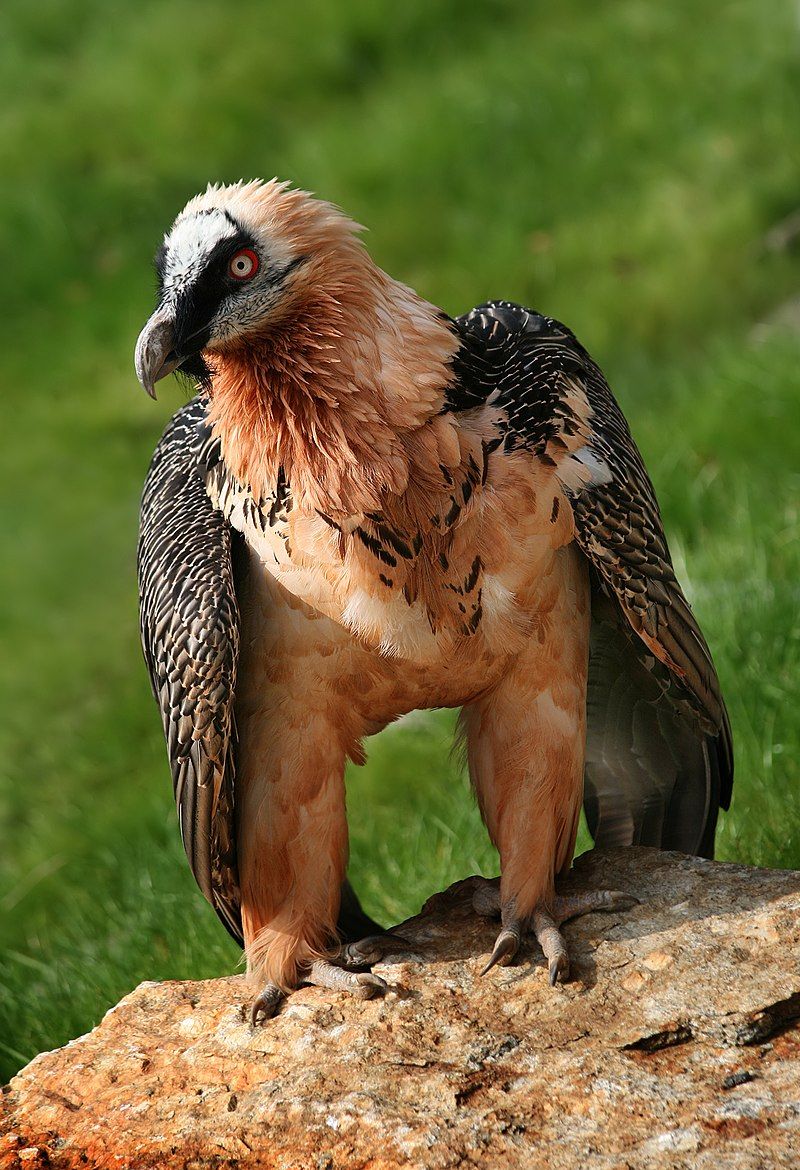
The bearded vulture is a massive bird of prey and is the only member of the genus Gypaetus. It is commonly referred to as the lammergeier or ossifrage and has traditionally been classified as an Old World vulture.
However, recent studies have revealed that the bearded vulture is more closely related to the Egyptian vulture, forming its minor branch within the Accipitridae family. The bearded vulture is a large bird with a 180 to 250 centimeters wingspan.
Its body is covered in brown and white feathers and has a distinctive yellow head and neck.
Its name comes from the black feathers that form a tuft on its chin, giving it a bearded appearance. The bearded vulture lives mainly in the mountains, where it can be found scavenging for food.
It prefers to eat the bones of dead animals and will often carry them to the top of a cliff to break them open.
It also eats carrion and sometimes takes live prey such as small mammals and reptiles. The bearded vulture is a protected species, and its population is currently in decline due to habitat destruction and hunting.
Conservation efforts are being made to help protect the species, including establishing protected areas and captive breeding programs. With proper management, the bearded vulture can continue to be an essential part of the natural landscape for years.
| Kingdom | Animalia |
| Phylum | Chordata |
| Class | Aves |
| Order | Accipitriformes |
| Family | Accipitridae |
| Genus | Gypaetus |
| Species | G. barbatus |
2. Spanish Imperial Eagle
The Spanish imperial eagle is a large species of bird native to the Iberian Peninsula. It is also known as the Iberian imperial, Spanish, or Adalbert’s eagle. It is named after Prince Adalbert of Bavaria, an ornithologist who studied the species.
The binomial name of the Spanish imperial eagle is a tribute to Adalbert, as it commemorates his work. The Spanish imperial eagle is a large bird with a wingspan of up to four feet and a body length of up to two and a half feet.
It is brownish black and white, with a grayish head and a white throat. Adult birds have yellow eyes and yellowish-orange beaks. The underparts of the birds are white, and the tail is banded with white and black.
The Spanish imperial eagle is a top predator, feeding mainly on small mammals such as hares, rabbits, and rodents. It also eats birds, reptiles, and other small animals. It often preys on young livestock, which can be a problem for farmers.
It is an endangered species whose population is declining due to persecution, habitat loss, and human disturbance. The Spanish imperial eagle is an important species in the Iberian Peninsula and is vital to the region’s ecology.
It symbolizes freedom and strength, and its presence is seen as a sign of good luck. The species is protected by law in Spain, and conservation efforts are being made to help protect the species and its habitat.
| Kingdom | Animalia |
| Phylum | Chordata |
| Class | Aves |
| Order | Accipitriformes |
| Family | Accipitridae |
| Genus | Aquila |
| Species | A. adalberti |
3. Griffon Vulture
The Eurasian griffon vulture is a large bird of prey native to the Old World. It is from the family Accipitridae and is sometimes referred to as the Griffon vulture, though this name is also used to describe the entire genus.
This bird should not be confused with the other two species in the genus: the Rüppell’s griffon vulture and the Himalayan griffon vulture. The Eurasian griffon vulture is a large bird with a wingspan of up to 2.5 meters.
It is predominantly a scavenger, feeding on carrion of various species, including wild and domestic animals. Its plumage is greyish-brown primarily, and its head is covered with white down.
The Eurasian griffon vulture has a bald head, which is thought to help it keep cool when soaring in hot temperatures. The Eurasian griffon vulture breeds in colonies, often on cliff faces.
The breeding season is from February to July, with the eggs hatching after approximately 55 days. The young birds fledge after about 100 days.
The Eurasian griffon vulture is listed as Vulnerable by the IUCN and is declining in population due to habitat loss, fragmentation, disturbance, poisoning, and illegal hunting.
| Kingdom | Animalia |
| Phylum | Chordata |
| Class | Aves |
| Order | Accipitriformes |
| Family | Accipitridae |
| Genus | Gyps |
| Species | G. fulvus |
4. Great Bustard
The great bustard is a large, ground-dwelling bird belonging to the bustard family. It is the only living species of the genus Otis. It is found in many habitats, including open grasslands, farmland, and temperate regions in Africa, Europe, and Asia.
It breeds in northern Morocco, South and Central Europe, and Central and East Asia. The great bustard is a large bird, usually around 90-110cm long. Its plumage is predominantly grey-brown with a white underside, and its head is crowned with a black crest.
It has a long neck, broad tail, and a distinctive white patch on the back. The great bustard is an opportunistic feeder, consuming various small animals and plant material. Its diet includes insects, rodents, lizards, and even fruit.
During the breeding season, the great bustard engages in elaborate courtship displays involving dancing, singing, and other posturing. The great bustard is a threatened species, with numbers declining significantly in recent years due to habitat loss and hunting.
Although it is still found in some areas, the species is listed as vulnerable by the International Union for Conservation of Nature (IUCN). Conservation efforts are being made to protect the species, including reintroductions in some areas.
| Kingdom | Animalia |
| Phylum | Chordata |
| Class | Aves |
| Order | Otidiformes |
| Family | Otididae |
| Genus | Otis |
| Species | O. tarda |
5. Bonelli’s Eagle
The Bonelli’s eagle is a large bird of prey found in the Mediterranean and parts of Africa and Asia. It is named after the Italian ornithologist and collector Franco Andrea Bonelli, who is credited with gathering the type specimen, likely during his exploration of Sardinia.
Bonelli was an essential figure in the study of birds, and the naming of the eagle in his honor acknowledges his contributions to the field of ornithology. Bonelli’s eagle is an impressive creature.
It has a wingspan of up to 6 feet and feeds primarily on small mammals, reptiles, and birds. Its feathers are dark brown, and its head and neck are often lighter.
It is considered a threatened species, and its population has declined due to the destruction of its habitat and illegal hunting. Conservation efforts are underway to help protect Bonelli’s eagle.
These include the establishment of protected areas, the reintroduction of birds into the wild, and the monitoring of illegal hunting. Additionally, educational campaigns are being launched to raise awareness of the species’ plight.
By increasing public knowledge and understanding of the species, it is hoped that more people will help to protect Bonelli’s eagle and its habitat.
| Kingdom | Animalia |
| Phylum | Chordata |
| Class | Aves |
| Order | Accipitriformes |
| Family | Accipitridae |
| Genus | Aquila |
| Species | A. fasciata |
6. Lesser Kestrel
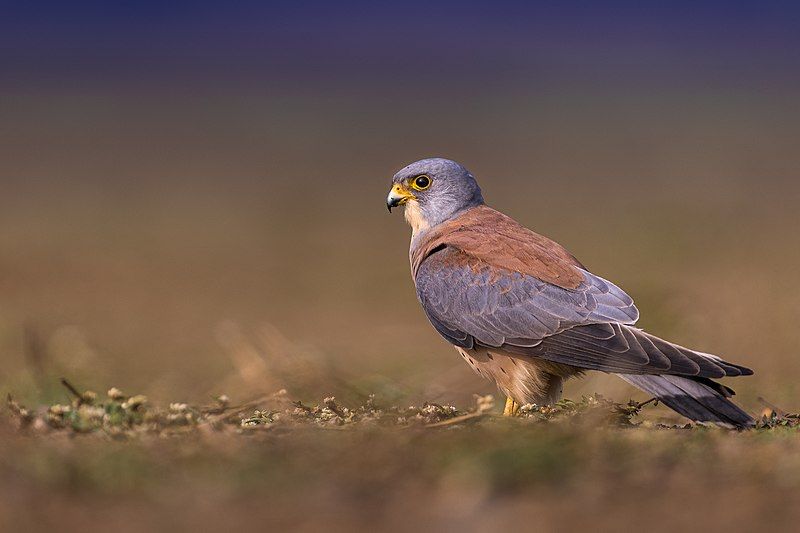
The lesser kestrel is a species of small falcon native to the Mediterranean region, extending from Afghanistan and Central Asia to China and Mongolia.
It is a migratory species, with the birds traveling away from their breeding grounds in the summer months to wintered locations in Africa, Pakistan, India, and Iraq. The lesser kestrel is not a common sight in its home range and is declining in its European range.
This could be due to several factors, such as a decrease in suitable habitat, reduced food sources, or human disturbance in the breeding and wintering grounds. Conservation efforts are therefore needed to ensure the survival of this species.
| Kingdom | Animalia |
| Phylum | Chordata |
| Class | Aves |
| Order | Falconiformes |
| Family | Falconidae |
| Genus | Falco |
| Species | F. naumanni |
7. Golden Eagle
The golden eagle is a majestic bird of prey found in many regions of the Northern Hemisphere. It’s the most widely distributed species of eagle, found in North America, Europe, Asia, and parts of northern Africa.
Golden eagles are part of the family Accipitridae, which includes all eagles, hawks, kites, and harriers.
As a top predator, they are one of the most recognizable birds of prey in the Northern Hemisphere. Golden eagles have a wingspan of up to 7 feet and can weigh up to 14 pounds. They have long, broad wings and a short, rounded tail.
They have a deep, powerful voice, and their call can be heard from far distances.
Their diet consists mainly of small mammals like rabbits, but they will also feed on birds, reptiles, and carrion. Golden eagles are potent hunters, able to dive at speeds up to 200 mph while chasing their prey.
They are also incredibly agile in the air, able to maneuver quickly and gracefully. They often soar high above the landscape or perch atop tall trees. Golden eagles are an important species to many cultures, usually considered a symbol of strength and power.
They are also keystone species, playing an essential role in maintaining the balance of their ecosystems. They are listed as a species of most minor concern by the IUCN, but their numbers are declining in some areas.
Conservation efforts are underway to help protect and preserve their populations.
| Kingdom | Animalia |
| Phylum | Chordata |
| Class | Aves |
| Order | Accipitriformes |
| Family | Accipitridae |
| Genus | Aquila |
| Species | A. chrysaetos |
8. Greater Flamingo
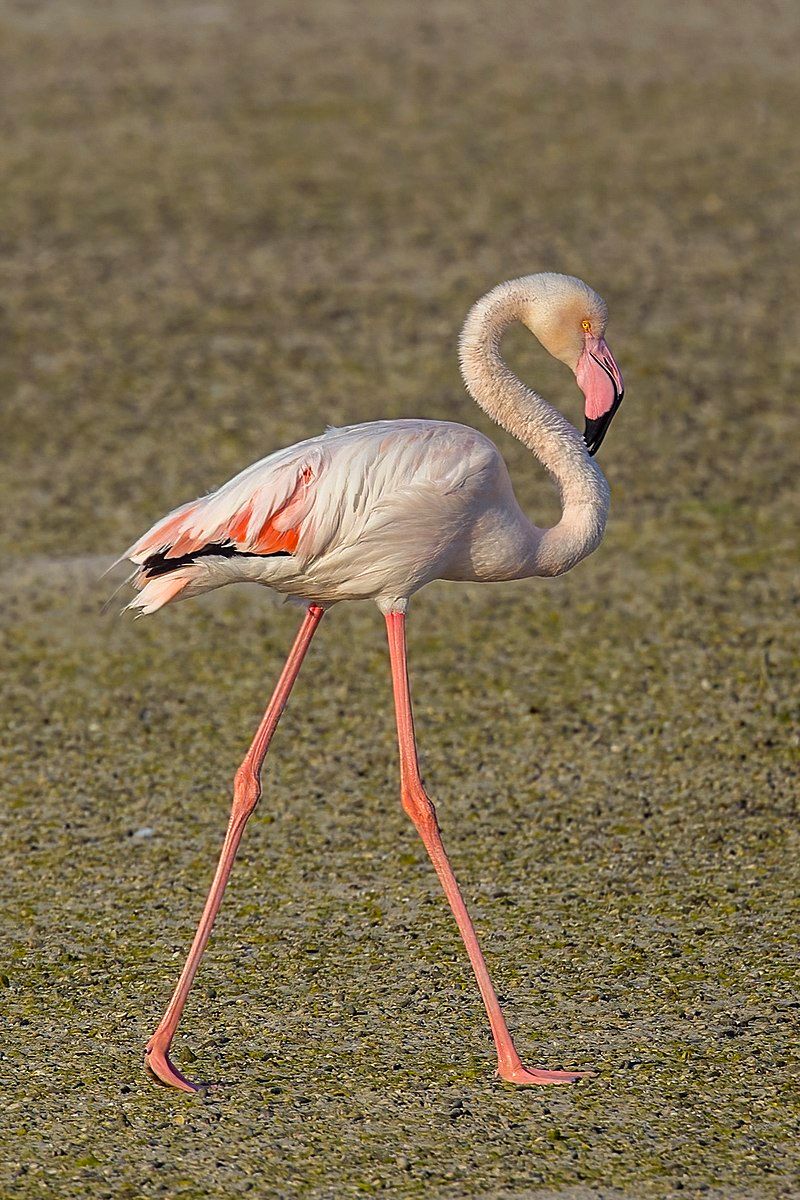
The greater flamingo is a species of bird that belongs to the flamingo family. It is the most widespread and most significant flamingos, with a range stretching across the Old World.
In Northern and Sub-Saharan Africa, greater flamingos can be found in various habitats, including lakes, lagoons, and wetlands.
The Indian Subcontinent, the Middle East, the Levant, the Persian Gulf, the Gulf of Aden, the Red Sea, and the Mediterranean countries of Southern Europe are also home to greater flamingos. These birds are highly social and often live in large colonies of several thousand individuals.
They feed on algae, small invertebrates, and aquatic vegetation. They have a specialized bill that helps them filter food from the water.
Their diet is supplemented with sand and mud, which helps them to grind food in their gizzard. The greater flamingo is a long-lived species, with a lifespan of more than 30 years in the wild.
They are also a long-distance migrant, traveling to warmer climates during winter. Females reach sexual maturity at three to four years of age and begin to breed in the spring. They lay a single egg incubated for 30 days before hatching.
The chicks are cared for by both parents and fledge in three to four months. The greater flamingo is an iconic species and is considered a symbol of the wetlands of the Old World.
Despite their wide range, they are listed as a species of most minor concern by the IUCN Red List.
| Kingdom | Animalia |
| Phylum | Chordata |
| Class | Aves |
| Order | Phoenicopteriformes |
| Family | Phoenicopteridae |
| Genus | Phoenicopterus |
| Species | P. roseus |
9. White-headed Duck
The white-headed duck is a small diving duck that grows up to 45 cm long. The male has a unique plumage; its head is white with a black crown, its bill is blue, and its body is reddish-grey. The female has a dark bill, and the overall color of her plumage is less vibrant.
The white-headed duck prefers to nest near lakes with open water and dense vegetation around the edges. This provides a safe and private environment for the duck to breed, as the vegetation provides camouflage, and the open water allows easy access to food sources.
The dense vegetation also makes it difficult for predators to reach the duck, giving them a better chance of survival.
| Kingdom | Animalia |
| Phylum | Chordata |
| Class | Aves |
| Order | Anseriformes |
| Family | Anatidae |
| Genus | Oxyura |
| Species | O. leucocephala |
10. Peregrine Falcon
The peregrine falcon is a large bird of prey that is found all over the world. It has a blue-grey back, barred white underparts, and a black head, making it distinct from other birds.
It is a member of the Falconidae family and has been known by a few different names throughout its existence, including the Duck Hawk in North America. The peregrine falcon is most famous for its incredible speed.
It can reach up to 200 miles per hour when it dives, making it one of the fastest animals on Earth. Its speed is so great that it can overtake and catch its prey mid-air.
This remarkable speed has made it a popular subject of study for scientists and a favorite among birdwatchers. The peregrine falcon is also an expert hunter with keen eyesight and sharp talons. It can spot its prey from far away and swoop down quickly to catch it.
This species has adapted to various habitats, from the open ocean to mountain peaks. It can survive in multiple climates, making it a truly global species.
The peregrine falcon is a remarkable bird of prey that humans have admired for centuries. Its incredible speed and hunting skills have made it a symbol of strength and agility, and its adaptability has made it one of the most widespread species of birds on the planet.
| Kingdom | Animalia |
| Phylum | Chordata |
| Class | Aves |
| Order | Falconiformes |
| Family | Falconidae |
| Genus | Falco |
| Species | F. peregrinus |
11. Blue Rock Thrush
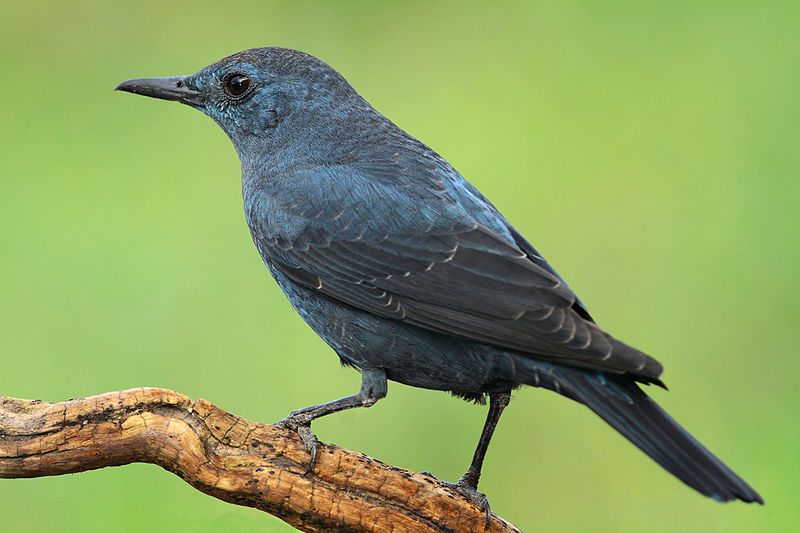
The blue rock thrush is a chat species belonging to the family Turdidae. This thrush-like Old World flycatcher is found worldwide, breeding in southern Europe, northwest Africa, Central Asia, northern China, and Malaysia.
This species of chat has adapted to living in various habitats, ranging from rocky and semi-desert areas to open woodlands and forests. The blue rock thrush is a medium-sized bird with a length of around 25 cm and a wingspan of 45 cm.
The bird’s head, neck, and breast are dark grey, while the back is brownish. The tail is long and pointed, and the wings are short and rounded. The eyes are yellow-orange, and the bill is black. The blue rock thrush prefers to feed on insects, larvae, and berries.
It is an omnivore that sometimes feeds on small rodents and birds.
During the nesting period, these birds may be seen in pairs, searching for food and nesting materials. The blue rock thrush is a fairly common species, but its numbers have declined in some regions due to habitat loss.
It is listed as a species of most minor concern by the IUCN, but ongoing conservation efforts are needed to protect this species in the future.
| Kingdom | Animalia |
| Phylum | Chordata |
| Class | Aves |
| Order | Passeriformes |
| Family | Muscicapidae |
| Genus | Monticola |
| Species | M. solitarius |
12. Booted Eagle
The booted eagle is a medium-sized bird of prey found mainly in the Palearctic and southern Asia. It migrates to warmer regions in winter, such as the tropics of Africa and Asia, and there is a small, isolated breeding population in southwestern Africa.
It belongs to the family Accipitridae, a large group of raptors that includes all types of eagles. The booted eagle has a wide distribution in its range and is often seen soaring in the sky or perched in trees.
Its diet consists mainly of medium-sized mammals, such as hares, rabbits, rodents, and birds. A mighty hunter uses its sharp talons and beaks to kill its prey.
The booted eagle is an integral part of the food chain, helping to balance the population of its prey species.
| Kingdom | Animalia |
| Phylum | Chordata |
| Class | Aves |
| Order | Accipitriformes |
| Family | Accipitridae |
| Genus | Hieraaetus |
| Species | H. pennatus |
13. Red-necked Nightjar
The red-necked nightjar is a species of bird that is found in Europe. It is the largest of the nightjars that inhabit this region, with a wingspan of up to 53 cm.
This species breeds in Iberia and North Africa during the warm months and migrates to tropical West Africa during winter. During this journey, they fly up to 8,000 km, making them one of the most long-distance migrants on the European continent.
Their plumage is typically grey-brown and mottled, with a distinctive red patch near the back of their neck. In the breeding season, the males have a white throat patch, which they use to attract mates.
During the day, the red-necked nightjar is well hidden, making it difficult to detect. At night, they are active and can be heard singing from the treetops.
| Kingdom | Animalia |
| Phylum | Chordata |
| Class | Aves |
| Clade | Strisores |
| Order | Caprimulgiformes |
| Family | Caprimulgidae |
| Genus | Caprimulgus |
| Species | C. ruficollis |
14. Ferruginous Duck
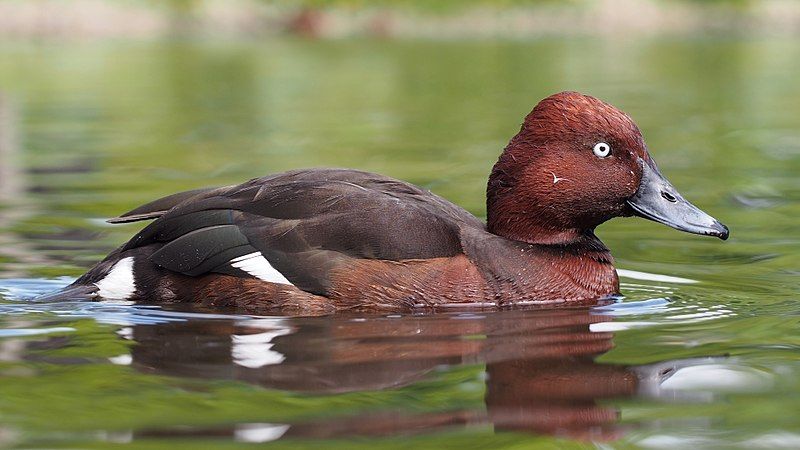
The ferruginous duck is a species of duck that is native to Eurosiberia. It is also known as ferruginous pochard, common white-eye, or white-eyed pochard. It is a medium-sized diving duck that gets its scientific name from Greek sources.
Lithuania is derived from ancient authors such as Hesychius and Aristotle, who mentioned an unidentified seabird. The word nyrok is taken from the Russian name for duck. The ferruginous duck is a unique species of duck that is known for its distinctive appearance.
It has a reddish-brown head and upper neck, a white chest, and a black patch on its back. Its wings are brown with a white patch, and the underside is white. Its tail is dark brown, and its bill is black.
The ferruginous duck has a lifespan of up to 10 years and prefers wetlands and shallow lakes. The ferruginous duck is considered a vulnerable species due to its declining population. Hunting, habitat degradation, and climate change have all contributed to its decline.
Conservation efforts are underway to help protect this species and ensure its future.
| Kingdom | Animalia |
| Phylum | Chordata |
| Class | Aves |
| Order | Anseriformes |
| Family | Anatidae |
| Genus | Aythya |
| Species | A. nyroca |
15. Little Bustard
The little bustard is a bird belonging to the bustard family, the only member of the genus Tetrax. This genus is derived from Ancient Greek and refers to a type of game bird described by Aristophanes and other renowned writers of that time.
This game bird is also known as a twite. These birds are usually found in open grassland, heaths, and other habitats that provide plenty of space for their long and powerful leaps. They feed on beetles, grasshoppers, and other insects.
They are also known to eat small amounts of plant material, depending on the season. Their diet is supplemented with other birds’ eggs and even small mammals.
The little bustard is threatened due to the destruction of its natural habitat and the introduction of new predators, such as foxes and cats. Conservation efforts are underway to ensure the survival of this species.
| Kingdom | Animalia |
| Phylum | Chordata |
| Class | Aves |
| Order | Otidiformes |
| Family | Otididae |
| Genus | Tetrax |
| Species | T. tetrax |
16. Red-knobbed Coot
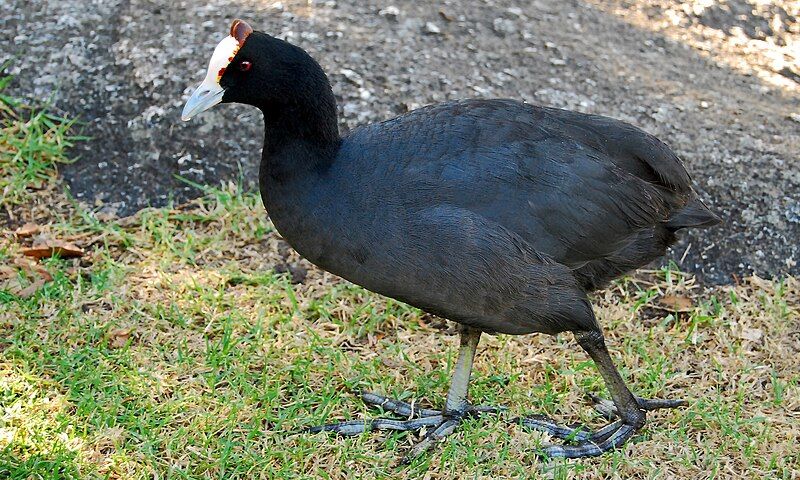
The red-knobbed coot, also known as the crested coot, is a species of bird belonging to the Rallidae family. It is a widespread species in many areas of Africa and southernmost Spain.
This bird is usually found near freshwater lakes and ponds, where it builds a nest of dead reeds. This nest is usually built either close to the shore or afloat, and the female red-knobbed coot typically lays around seven eggs.
This species is a resident breeder, meaning it stays in the same area year-round and returns to the same nesting sites. The red-knobbed coot is a social species, often forming large colonies near its nesting sites. It feeds mainly on aquatic plants, insects, and mollusks.
This species has a distinctive red knob on its forehead, which is used to identify it from other species of waterfowl.
| Kingdom | Animalia |
| Phylum | Chordata |
| Class | Aves |
| Order | Gruiformes |
| Family | Rallidae |
| Genus | Fulica |
| Species | F. cristata |
17. Northern Bald Ibis
The northern bald ibis, hermit ibis, or waldrapp, is a large migratory bird species. It has a glossy black body approximately 70–80 cm long. Unlike many other members of the Ibis family, the northern bald ibis does not wade in the water.
It has a characteristic red face and head, which are entirely unfeathered, and a long and curved red bill. The northern bald ibis is usually found in barren, semi-desert, or rocky habitats, often near running water.
It is a pretty social species and often forms large breeding colonies. These colonies are usually found in areas with plenty of food sources, such as wetlands, grasslands, and agricultural regions.
It is also an important pollinator of local plants and flowers. The northern bald ibis has a long and storied history. It is known to have existed since ancient times, with records of it being seen by the Greeks and Romans.
In recent years, however, its numbers have declined due to human activities such as habitat destruction, hunting, and pollution. As a result, it is now considered endangered, and conservation efforts are underway to help protect this species.
| Kingdom | Animalia |
| Phylum | Chordata |
| Class | Aves |
| Order | Pelecaniformes |
| Family | Threskiornithidae |
| Genus | Geronticus |
| Species | G. eremita |
18. Trumpeter Finch
The trumpeter finch is a small bird in the Fringillidae family, commonly known as finches. It is a species that mainly lives in desert areas, ranging from North Africa, Spain, and even as far as southern Asia.
It has also been known to wander into places even further north than its natural habitat, such as when it has been spotted as a vagrant in various places. This finch species is known for its unique call, a loud, two-tone trill.
It is a social bird, often seen in flocks, and is known to feed on tiny seeds, grains, and insects. The trumpeter finch is a relatively hardy species, able to survive in extreme conditions, and is an essential species in the local ecology.
| Kingdom | Animalia |
| Phylum | Chordata |
| Class | Aves |
| Order | Passeriformes |
| Family | Fringillidae |
| Genus | Bucanetes |
| Species | B. githagineus |
19. Black-winged kite
The black-winged kite, also known as the black-shouldered kite, is a bird of prey in the Accipitridae family. It is a small diurnal bird that is active during the day. The black-winged kite is best known for its unique hovering behavior.
It hovers over open grasslands, similar to how the much smaller kestrels do. This hovering behavior allows the black-winged kite to spot prey easily. The black-winged kite typically feeds on small mammals, reptiles, amphibians, insects, and other birds.
It prefers to hunt in open areas, where it can easily spot its prey. The black-winged kite is found in many parts of the world, including Africa, Australia, Asia, and Europe. They can be seen flying alone or in pairs, often gathering together in flocks during migration.
The black-winged kite is an essential part of the food chain, helping to keep populations of small mammals and other prey in check.
| Kingdom | Animalia |
| Phylum | Chordata |
| Class | Aves |
| Order | Accipitriformes |
| Family | Accipitridae |
| Genus | Elanus |
| Species | E. caeruleus |
20. Spotless Starling
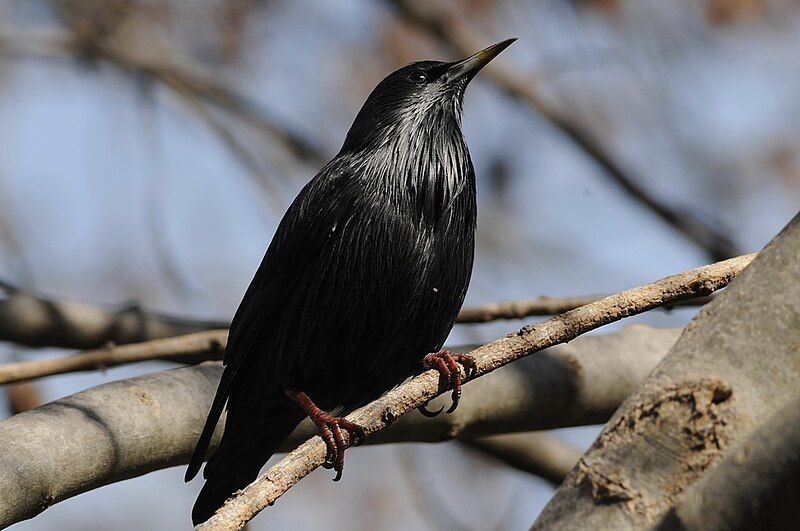
The spotless starling is a member of the Sturnidae family, which includes the common starling.
However, its range is much more limited than the common starling, as it is found in the Iberian Peninsula, Northwest Africa, southernmost France, and the islands of Sicily, Corsica, and Sardinia.
Unlike many other birds, the spotless starling does not migrate; it remains in the same region year-round. This is likely because its range is so limited, and it may be unable to find food or shelter in other areas.
It is possible that this species evolved from the common starling, adapting to the specific climate and ecology of its more limited range. Highly adapted to its environment, the spotless starling is a unique and fascinating species.
| Kingdom | Animalia |
| Phylum | Chordata |
| Class | Aves |
| Order | Passeriformes |
| Family | Sturnidae |
| Genus | Sturnus |
| Species | S. unicolor |
21. Subalpine Warbler
The Western Subalpine Warbler is a small species of warbler breeds in the Mediterranean region of Europe and the western areas of North Africa.
It is recognized as a typical warbler, belonging to the genus Curruca, which is generally characterized by a distinct difference in the plumage of males and females.
The adult male of this species is easily identified by its grey back and head, brick-red underparts, and white malar streaks (the two white streaks that run down either side of the head).
Males of this species are typically more brightly colored than the females, with the females having a duller grey and brown coloration. In addition to its bright coloration, the male of this species also displays a yellowish-white throat patch.
The Western Subalpine Warbler is a fairly common species, with its population remaining relatively stable in recent years.
| Kingdom | Animalia |
| Phylum | Chordata |
| Class | Aves |
| Order | Passeriformes |
| Family | Sylviidae |
| Genus | Curruca |
| Species | C. iberiae |
22. Mediterranean Short-toed Lark
The Mediterranean short-toed lark is a small passerine bird in and around the Mediterranean Basin.
It is a common species with an extensive range that extends from the Canary Islands in the north to the Iberian Peninsula in the west and throughout North Africa to the Middle East.
This species is found in various habitats, from open grassland and scrubland to cultivated fields and orchards. The Mediterranean short-toed lark is often seen perched atop tall vegetation or on rocks, singing its distinctive song.
Its diet consists mainly of small insects and seeds, which it forages for on the ground. This species is usually seen in pairs or small flocks, and their nests are typically built on the ground or in low shrubs.
The Mediterranean short-toed lark is a pretty adaptable species but is threatened by habitat destruction and fragmentation due to human activities. It is, therefore, essential to protect their natural habitats to ensure this species’ long-term survival.
| Kingdom | Animalia |
| Phylum | Chordata |
| Class | Aves |
| Order | Passeriformes |
| Family | Alaudidae |
| Genus | Alaudala |
| Species | A. rufescens |
23. Red-rumped Swallow
The red-rumped swallow is a small passerine bird species belonging to the swallow family. This bird species is native to temperate Southern Europe and Asia, ranging from Portugal and Spain to Japan, India, Sri Lanka, and tropical Africa.
The populations of red-rumped swallows residing in India and Africa are sedentary, meaning they do not migrate.
On the other hand, the populations of red-rumped swallows in Europe and other parts of Asia are migratory, meaning they migrate to different locations during different times of the year. The red-rumped swallow typically inhabits open hilly areas in these regions.
It often builds its nest near water sources, such as streams and rivers, and relies on insects as its primary food source. Its scientific name is Hirundo daurica, and it is known for its reddish-brown rump, a distinctive feature of this species.
The red-rumped swallow is a social bird and forms flocks during its migrations. It is a widespread species and is considered a species of most minor concern in terms of conservation.
| Kingdom | Animalia |
| Phylum | Chordata |
| Class | Aves |
| Order | Passeriformes |
| Family | Hirundinidae |
| Genus | Cecropis |
| Species | C. daurica |
24. Red Kite
The red kite is a bird of prey belonging to the Accipitridae family. This family includes other birds of prey that are mainly active during the day, such as eagles, buzzards, and harriers.
The red kite is found mainly in Europe, though in the past, it used to breed in parts of West Asia and Northwest Africa as well. They are medium to large-sized birds with distinct reddish-brown wings and a forked tail.
They feed mainly on small rodents, reptiles, and insects, but they have also been known to scavenge for food from garbage. Red kites are also known to steal food from other birds. They form strong bonds with their mates and are known to mate for life.
Conservation efforts have successfully restored the red kite population in Europe, though they are still endangered.
| Kingdom | Animalia |
| Phylum | Chordata |
| Class | Aves |
| Order | Accipitriformes |
| Family | Accipitridae |
| Genus | Milvus |
| Species | M. milvus |
Conclusion
The diverse avian population in Jaén offers both residents and visitors a captivating opportunity to connect with nature. With 24 unique bird species to observe, ranging from majestic raptors to colorful songbirds, the region’s rich biodiversity is truly a treasure.
Through careful conservation efforts and responsible ecotourism practices, we can ensure the preservation of these magnificent creatures and their habitats for generations to come.